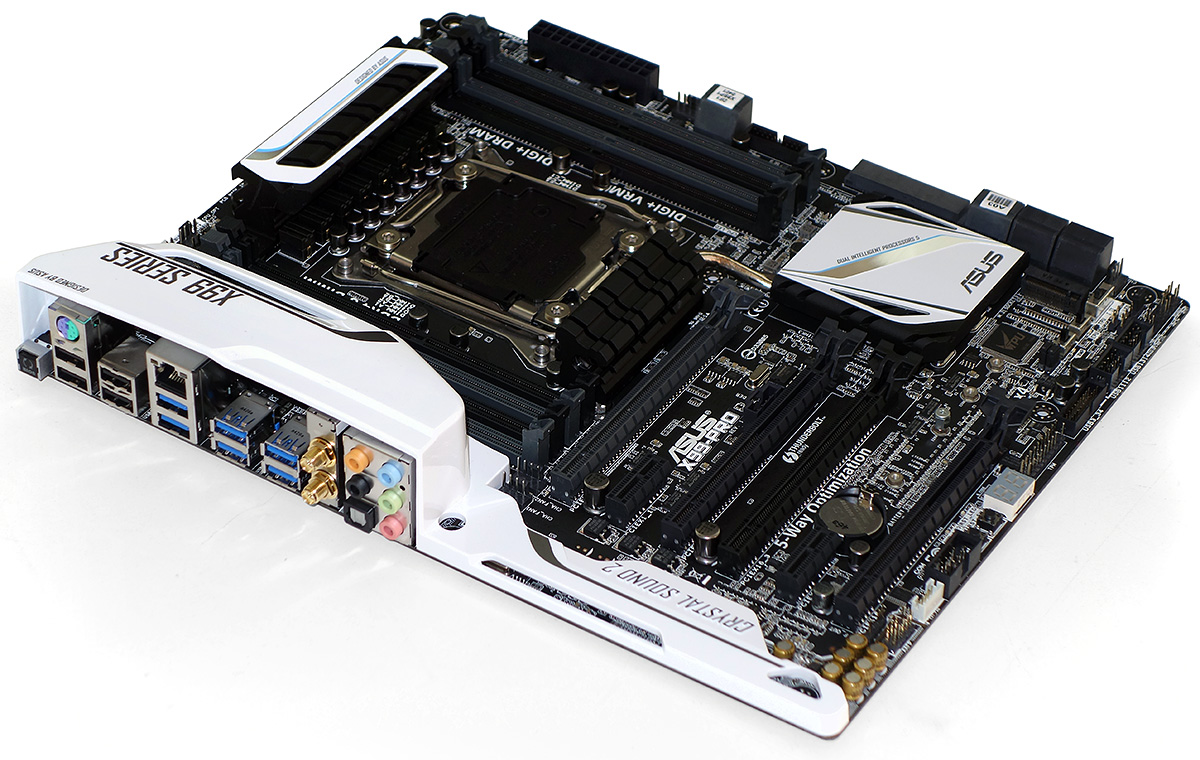Asus X99 Pro Motherboard Review: More Memory Multipliers
The first motherboard in our labs to support unofficial memory multipliers, Asus’ X99 Pro quickly became the go-to product for our recent DDR4 roundup. Does the X99 Pro have enough additional features to justify its over-$300 price?
Why you can trust Tom's Hardware
Getting To Know Asus’s X99 Pro
A quick look around back shows the dual-band Wi-Fi module, two extra USB 3.0 ports and a CLR_CMOS button that, in Asus tradition, also serves as USB BIOS Flashback. The last bit means the board also contains an ASIC that allows firmware flashing without CPU or DRAM access, which is specifically useful when buying an old-stock board that requires a UEFI update to support recently-launched CPUs. Most recently, this was a life saver for value-seekers who bought Z87 motherboards and refreshed Haswell-based parts at the same time.
Asus says that five of the I/O panel’s six USB 3.0 ports are actually connected to an ASM1042e controller and four-port ASM1072 hub. Though the firm doesn’t clarify whether the hub is connected to the third-party controller or the chipset’s missing USB 3.0 port, my money is on the latter. This would allow bandwidth sharing in a 3 (through hub)-2 (though controller)-1 (through chipset) configuration.
There isn’t as much bandwidth sharing going on internally as I might have expected, though, as the X99 Pro lacks the four-port PCIe 2.0 bridge found on some competing products. It even lacks many of the pathway switches found on other vendors' boards. Rather than give users a four-by-eight (slots and lanes) option for the PCIe x16 slots, the first and third x16 slots are wired as x16, and the fourth as x8. Core i7-5820K users who thought they’d get three-way SLI are negatively affected most; their 28-lane CPU drops the X99 Pro to x16-x8-x4, rather than the expected three-by-eight configuration. And SLI doesn’t support x4.
That won't matter to early adopters snatching up PCIe x4-based M.2 SSDs. Doing so switches off the fourth slot entirely, making this a motherboard capable of hosting two graphics cards. If you’re thinking “I could have done that with Z97”, you’re right. But if it matters to you, the X99 Pro gives those two cards up to 16 lanes each, as opposed to Z97’s x8/x8 split.
You’re probably thinking, “I can still use the M.2 slot in SATA mode to preserve the functionality of the eight-lane PCIe x16 slot”. But you can’t. Asus says that the M.2 slot is PCIe-only.
You may have noticed that I didn’t mention the second x16 slot yet, and it’s not because that slot isn’t spaced for accommodating a graphics card. Instead, by default, this slot is PCIe 2.0 x1. Enabling PCIe 2.0 x4 mode means disabling two of the I/O panel’s USB 3.0 ports (the AMS1042e’s interface) and the upper PCIe x1 slot. And using the second PCIe x1 slot means disabling the Wi-Fi controller (another PCIe lane). After paying $50 for that Wi-Fi module, you probably wouldn’t do that.
I'd say that Asus might as well have made this a microATX motherboard, except that it wouldn’t have had all that extra space for features below the forth slot like the three-way SLI-disabling M.2 slot, the second front-panel USB 3.0 interface, the TPU (automatic overclocking) and EPU (automatic underlocking) switches, the auto-XMP switch, the two-digit status code display, the power button or the reset button. Then again, at least one of these features (the USB 3.0 header) gets blocked if you use a third graphics card, but not when installing an M.2 module.
Get Tom's Hardware's best news and in-depth reviews, straight to your inbox.
The X99 Pro has a lot of really great features too, such as the SATA Express connector for two of the SATA ports, dual-mode fan control (voltage and PWM) for five of the six four-pin headers, a five-pin EXT_FAN header for Asus’ fan extension card, a TB Header for adding a Thunderbolt expansion card, a primary USB 3.0 front-panel header that isn’t blocked by anything and a front-panel audio header moved forward slightly so that it works with the plethora of cases that have slightly too-short cables. And let’s not forget the plastic piece; it looks pretty cool too.
Packed with SATA cables, the X99 Pro’s installation kit even includes the firm’s “Hyper M.2 x4” PCIe-to-M.2 adapter. You probably won’t use the adapter in the board’s fourth slot because it gets disabled when using the identical on-board M.2 interface. And you probably won’t use it in the second PCIe x16 slot, since that one runs at PCIe 2.0 x1 by default (disabling other devices when set to x4 mode). So, the best option is in PCIe x16 slot three, thereby limiting the motherboard to a single graphics card.
After covering all of the X99 Pro’s slot limitations, we can almost forgive Asus for not including a three-way SLI bridge. Less forgivable is that the motherboard’s overview page lists “Support for both Nvidia SLI and AMD CrossFire 2/3-way configurations” plus “CPU 28-lane 3-way/2-way” support, while requiring that buyers know on their own or by digging deep into the specifications page that three-way for 28-lane processors is a CrossFire-only feature.
Current page: Getting To Know Asus’s X99 Pro
Prev Page Give Me More (Of Everything) Next Page X99 Pro Firmware And Software


